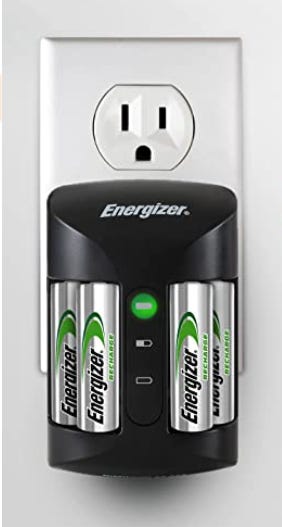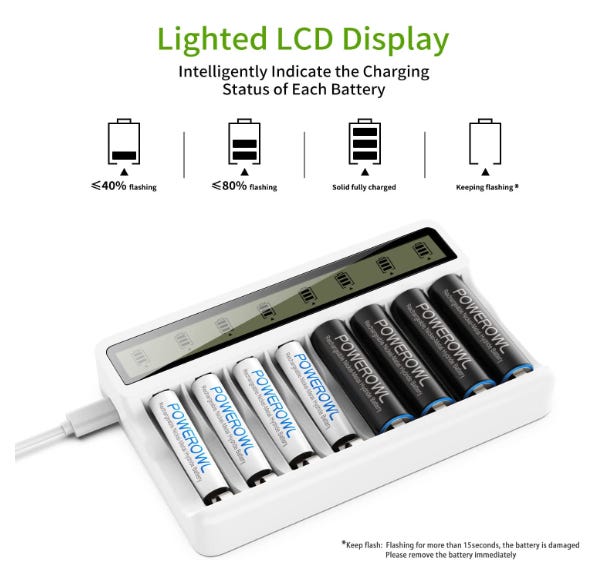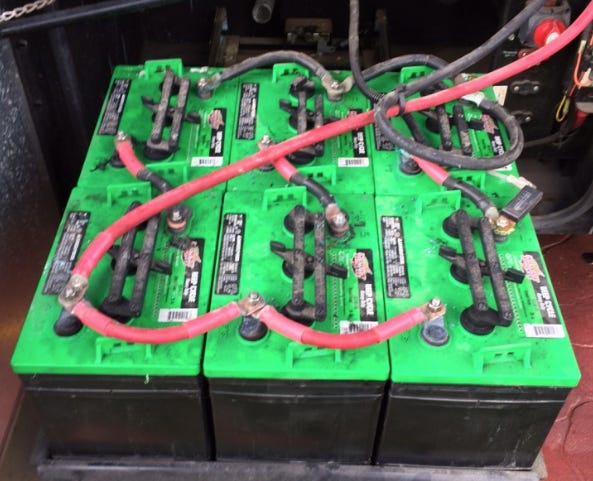My guitarist of 40+ years (Karl) called me other day asking what I knew about battery chargers. He had purchased a portable guitar amplifier that needed 8 AA rechargeable batteries. He popped in the batteries, plugged in his guitar, and the amp shut down on the first note.
The plot begins…
He dragged out an extension cord and plugged in the wall wart to get it working, but his dream of playing on battery power alone seemed to be lost.
He had charged the new batteries overnight as advised, and the charger said the batteries were full. See above for what he was using for batteries and the charger that came with them.
The plot thickens
I’ve had this exact thing happen to me with the same charger and batteries, and it seemed like the charger would shut off after the first battery reached 100% charge, and there could be other batteries in the same charger with only 50% SoC or less.
So I told Karl to check each battery individually, and that was it… While he had several batteries at 100% charge, other batteries were at 50% and one was as low as 30%. Just as I had predicted, the “dumb” charger that came with the rechargeable batteries had shut off when the first battery reached 100%, and the rest of the batteries were not fully charged. So unless every battery was at the exact same state of discharge, this type of charger would never get all of them up to 100% SoC (State of Charge).
What’s the solution?
Glad you asked… I found another class of “Smart Chargers” that monitors each battery independently, so you can charge up to 8 batteries at a time and they’ll all end up at 100% without overcharging. Here’s what I bought, and it worked perfectly for my rechargeable batteries. You can buy one on Amazon for less than $20 HERE.
Does the same sort of thing happen in your RV?
Oh yes it does. If you have multiple batteries in your RV, and they are perfectly matched in age, then a single charger will probably work just fine. However, if you accidentally let everything go flat by leaving the disconnect switch on for weeks or a month, then all batteries might not charge back up exactly the same way.
So if a complete discharge happens I think it’s the best policy to disconnect them from each other (after marking all cables and connections properly) and recharge each battery one at a time with a smart charger. And if the battery is completely dead, you might need to use a “dumb” charger on them for an hour to get the battery voltage up to the point where the smart charger can recognize it and turn on properly.
More on this later
I'll cover the differences between all the various RV chargers in a future article. But just know that not all chargers are created equal, and some can destroy your expensive batteries.
Let’s play safe out there - Mike
Some of the products above have affiliate links. This means that, at zero cost to you, I will earn a commission if you click through the link and finalize a purchase. But feel free to find the best deal anywhere you like.









Subject: 12 Volt RV chassis or 6 Volt House Battery Chargers
Mike,
Do you think a "PULSE DESULFATOR" , described as automatic "high frequency" pulse desulfator (not high voltage) like the "BatteryMINDer 1500'" really works to help extend batter life and fully charge my 12 volt Lead Acid chassis batteries and the four lead acid house batteries when the coach is in storage in a temperature controlled garage in the mile high Arizona midlands..
Lowest Temp set at 40F and Highest 90F..
I don't understand what a "High Frequency Pulse" is or how it gets to the battery?
Hope you can help.
I've been using one for two years and it seems to keep the batteries charged but the idea of a "high frequency " sounds like more advertising and marketing then then something unique or special...
Any thoughts would be appreciated
Thanks
Jim Anderson
"...the charger would shut off after the first battery reached 100% charge, and there could be other batteries in the same charger with only 50% SoC or less."
I did not know this! Thanks, Mike :)